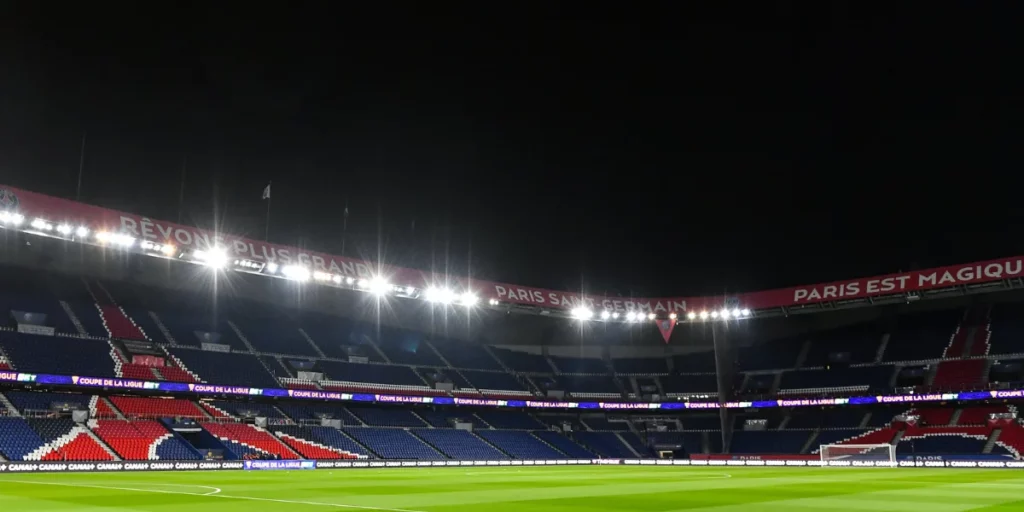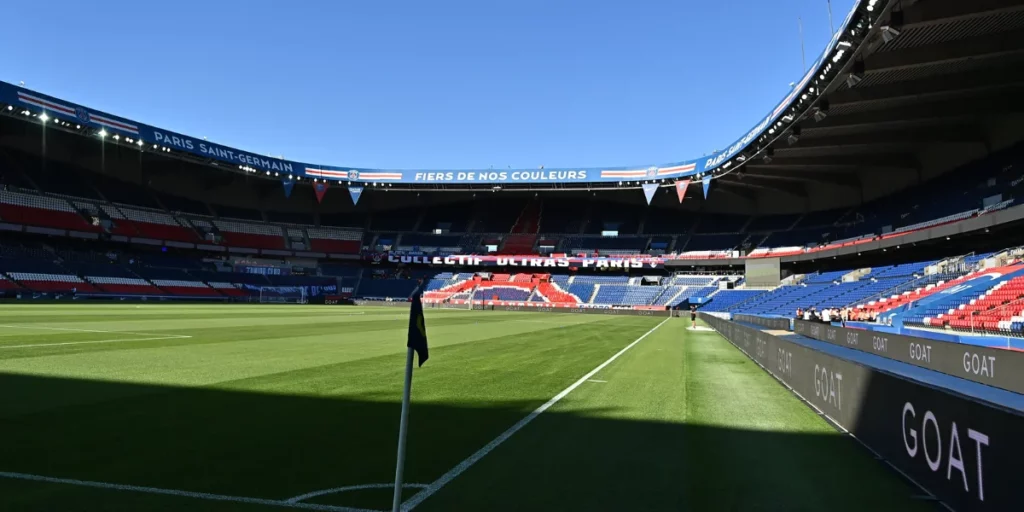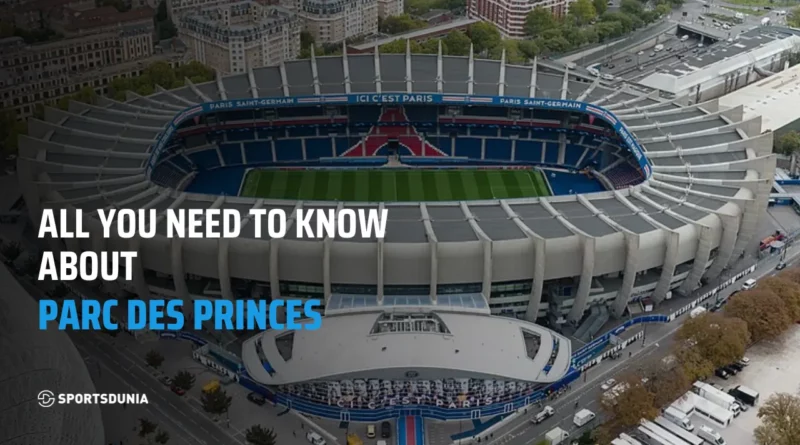Parc des Princes: Capacity, Size, Events, Tickets and Legacy
Parc des Princes is an iconic French stadium in the city of Paris. The 47,929-capacity, all-seater stadium is also home to the French giant Paris Saint-Germain. The stadium, in its rich history, has hosted multiple World Cups, European Championships, Summer Olympics, and other high-profile events. It is a legally protected icon of French architecture.
Parc des Princes was originally built in 1897 and it had a cycling track as a main feature of the stadium. The current version of the stadium is the third iteration to be built on the same site. Multiple plans have been made to renovate this stadium that opened its doors 52 years ago.

Paris Saint-Germain occupied the stadium once they established themselves as a top-flight team. They have seen incredible highs at the stadium and have often boasted teams of world-beaters. The stadium owned by the Paris City Council was a key establishment in whichever event the country hosted.
Let us learn more about the famed Parc des Princes, its history, capacity, ticket prices and upcoming events in the stadium.
| Stadium Name | Parc des Princes |
| City | Paris |
| Area | 16th arrondissement of Paris |
| Owner | Paris City Council |
| Home to | Paris Saint-Germain |
| Capacity | 47,929 |
| Pitch Size | 105 m length by 68 m width |
| Major Events | Ligue 1, UEFA Champions League, UEFA Euros, World Cup, Women’s World Cup, Summer Olympics, Rugby League World Cup, Cycling |
Introduction
Overview of Parc des Princes
Parc des Princes was first unveiled in 1897. The stadium went by the name of Stade Velodrome du Parc des Princes. It had a huge cycling track and hosted plenty of other events like cycling and rugby events.
In the early 1930s, the stadium got its first revamp. Its capacity was increased to 45,000 and roofing was introduced. During this time, the stadium played host to FIFA World Cups and European Championships.
The third major facelift took place in 1972. Famed architects were roped in to build an iconic structure. Special care was taken in installing first-of-its-kind features in the stadium. It was also the biggest stadium in France till the Stade de France took its crown in 1998.
After the QSI took over PSG in the early 2010s, they had ambitious plans for the redevelopment of the stadium. They want to buy the stadium and make it one of the world’s best.
Location of Parc des Princes
The stadium is in the famed sporting district that also has the Stade Jean-Bouin and Stade Roland Garros. The area of the original stadium was a forested parkland used by the royal family. After the French Revolution, the city council took charge of the area. Thus, it earned the name of Parc des Princes.
Also Read: Stamford Bridge Stadium: Capacity, Size, Events, Tickets and Legacy
Parc des Princes
Construction and Opening of Parc des Princes
Henri Desgrange, a famous racing cyclist, was appointed the director of the project to build a new stadium. Desgrange was a famous racer during his racing career. He set twelve world-track cycling records and was also the founder of the Tour de France. Desgrange was also the founder of the cycling magazine L’Auto, the predecessor of L’Equipe.
His vision helped the first version of Parc des Princes take shape. It was called Stade Velodrome du Parc des Princes and was inaugurated on 18 July 1897. The velodrome had more than 3,000 seats. Its main feature was a 728-yard track that could host both cycling and track and field events. The stadium held the 1900 UCI Track Cycling World Championships. It also marked the finish of the Tour from its first edition in 1903 until 1967.
In 1903, the stadium held its first-ever football match. A team full of Parisian players took on an English side and lost 11-0. A couple of years later, France played its first international game at the stadium against Switzerland.
In 1906, the France national rugby union team made their debut against New Zealand at the stadium. The stadium’s capacity was increased to 20,000, keeping the 1924 Summer Olympics in mind. However, Stade Olympique Yves-du-Manoir took the shine by hosting the games.
Renovations of Parc des Princes
Desgrange and his business partner, Victor Goddet, wanted to expand the stadium. In the early days of 1930, they planned and carried out a thorough reconstruction of the stadium. The expanded sports arena now had 45,000 visitors and a total of 26,000 seats were covered.
At the time of its opening on 19 April 1932, the capacity was reduced to 38,000 for greater comfort. The 454-metre cycling track was still a prominent feature of this stadium. The second iteration of Parc des Princes hosted many prominent events like the World Cup, UEFA Champions League, Euros, Rugby Leagues and Tour de France. Following the end of the Second World War, league football became a regular feature of the stadium.
In the 1970s, the stadium got a big makeover. The existing structure was torn down and a new stadium was built on the same site., The cycling track was removed and it was made as a pure football stadium. French architect Roger Tailibert and Iranian artist Siavash Teimouri came up with the design. It became one of the continent’s most emblematic and historic venues with an ode to French architecture.

The stadium had an elliptical roof with a first-of-its-kind lighting system integrated into it. The roof in itself had distinctive concrete ribs and a razor-styled design. The acoustic system was well-praised for enhancing the matchgoing experience. The stadium had four covered all-seater stands, officially known as Tribune Borelli, Tribune Auteuil, Tribune Paris, and Tribune Boulogne. The renovation works cost 150 million French Francs.
The next major reshuffle happened in 2013 when QSI reached an agreement with Paris City Council to extend their stadium lease for another 30 years, till 2043. They hired American architect Tom Sheehan and approved a €75 million upgrade. These were done with an eye on the 2016 UEFA Euros. Additional rows of seats were added to increase the capacity of the current one. Hospitality seats were tripled as the pitch and player facilities were massively improved, too.
New substitute benches, modern changing rooms, and treatment rooms were installed. All these features massively improved the stadium’s matchday revenue from €20 million to €100 million. The Qatar Sports Investments are rumored to have made attempts to buy the stadium for a fee of €150 million with a view on expanding its capacity to 60,000 and establishing it as one of the best ones in Europe.
Parc des Princes Capacity and Field Size
Parc des Princes has a current capacity of 47,929. This is the maximum crowd that the stadium has ever held in its history. The previous iterations had cycling tracks and not all sides had stands. The recent expansions helped the capacity swell to its current standards. Tarkett Sports GrassMaster was used to lay the pitch at the stadium. It is 105 metres in length and 68 metres in width.
Key Football Events at Parc des Princes
Domestic Football
Domestic football wasn’t a regular thing at Parc des Princes for many initial years. It did host the 1919 Coupe de France final and also four USFSA French Championship finals. But no team called it home domestically. It was only after the Second World War that the French football championship became regular. Stade francais-Red Star and Racing Paris were regularly playing at the ground.
The breaking up of Paris FC and Stade Saint-Germain meant PSG was born. PSG played their first game at the Parc des Princes in 1973. They returned to Ligue 1 in 1974 and moved into the stadium. Paris FC, their rivals who occupied the stadium to that point were relegated.
PSG dominated the numbers while playing at the stadium as Racing Paris and Paris FC shared the stadium too but couldn’t get the same numbers. They eventually became the sole tenants of the stadium and rebranded it in their mold. Their unparalleled domestic success after the takeover made the stadium a hub of success. However, they are keen to end the elusive drought for European success and paint the stadium with the Champions League.
International Tournaments
The stadium played host to the round of 16 and the semi-final clashes of the 1938 FIFA World Cup. Sixty years later, it also hosted six clashes of the 1998 edition, including the third-place play-off, round of 16, and four group stage games.
In 2019, the famed stadium took a part of history as the FIFA Women’s World Cup was played on its turf. The first-ever European Championships (UEFA Euros) were held in the stadium in 1960. The Soviet Union won the tournament after beating Yugoslavia.
France lifted the Euros for the first time in 1984 after getting the better of Spain at Parc des Princes in 1984. They couldn’t repeat the same feats in the 2016 edition, though, as the final was shifted elsewhere. Group stage games and only a single round of 16 clash took place at the stadium.
The stadium hosted three UEFA Champions League finals. Real Madrid won their first trophy here in 1956 and were on the wrong side of the scoreline in 1981 when Liverpool beat them. Bayern Munich won in 1975 after making light work of Leeds United. Multiple UEFA Cup Winners’ Cups and UEFA Europa League finals were also held here. The 2024 Summer Olympics added another feather in the cap of the stadium as both the men’s and the women’s finals took place at the Parc des Princes.
ALSO READ: Santiago Bernabeu Stadium: Capacity, Size, Events, Tickets And Legacy
Tickets and Pricing
How to buy Parc des Princes Tickets
The tickets for Parc des Princes can be purchased on the official ticket portal of PSG. The second half markets like StubHub and Viagogo. The site will let you buy single-match tickets as well as season tickets.
The hospitality tickets at PSG are priced at a premium but offer one of the best experiences in Europe. The special Collective club, Vendome club and International space, along with Europe space, will leave guests wanting more.
Visiting Parc des Princes
How to reach Parc des Princes
Parcs des Princes is easily accessible by the Paris Metro. Line 9 to Porte de Saint-Cloud will leave you just shy of a five-minute walk away from the stadium. Line 10 to Porte d’Auteuil will make it a 10-minute walk. The stadium is also accessible by car, but Paris traffic has a notorious name making public transport an easy route.
Guided Tours: Exploring Parc des Princes
Paris Saint-Germain offers the chance to tour the famed Parc des Princes. The tour takes you from the top of the stands to the substitutes’ dugout and the VIP boxes to the players’ tunnel. The tour is provided for fun and educational purposes.
The prices are very affordable as it costs only £25 for an adult to take the tour. For children under 13 and seniors over 65 years, the pricing is only £15. The tour can be booked on the official website.
Nearby Attractions for Football Fans
Paris is sprinkled with famous monuments and cultural heritage sites. Parc des Princes is just a stone’s throw away from the famous Stade Jean Bouin. The famous Stade Rolland Garros, which hosts the French Open, is also nearby.
La Seine Musicale is a large glass dome located on Seguin Island nearby that gives a unique musical experience. Saint-Germain Island departmental park and L’lle parks are a paradise for nature lovers to relax and bask in the sun. Famous museums like Les Etincelles du Palais de la Decouverte are all around the place. World-famous exhibits like the Eiffel Tower and the Louvre Museum are accessible by the nearby metro.
Parc des Princes Events Beyond Football
Other Sports
Parc des Princes held prestigious cycling and rugby events in the first two iterations. Let us take a look at the most famous events at the stadium.
- The 1900 UCI Track Cycling World Championships was held at the stadium.
- France’s national rugby team made its debut in 1906.
- The 1954 Rugby League World Cup final between Great Britain and France took place at the Parc des Princes.
- The 1972 Rugby League World Cup had the stadium as one of the venues.
- The stadium played host to the 1991 and 2007 Rugby World Cups.
- It also held the one-off finals of the 2001 European Rugby Champions Cup.
Musical Concerts
The stadium made its musical debut thanks to Michael Jackson. The pop icon made it an attractive venue as others rushed to perform there. Here are the famous concerts from the stadium.
- Michael Jackson’s concert in 1988 marked its debut and he performed again in 1997.
- The Rolling Stones and Prince performed in 1990.
- David Bowie performed at the Rock Festival in Paris in 1997.
- A series of concerts then took place, including the likes of Red Hot Chili Peppers (2004), Metallica (2004), Moby (2005), Iron Maiden (2005), Muse (2007) and Coldplay(2009).
- Green Day and Supremer NTM last performed in 2010, as the stadium went on a long break from concerts.
- DJ Snake broke the 12-year duck by performing in 2022. French singer Dadju followed in his footsteps shortly in the same year.
Conclusion
Scope of Parc des Princes in the future
Parc des Princes is one of the unique stadiums in the world where reconstruction took place multiple times in the same spot. The stadium also had a cycling track, unlike other venues with track and field events.
It earned a great reputation by hosting multiple World Cups and European Championships. For domestic football, there was always a void to be filled. Paris Saint-Germain filled that void when they moved to the stadium. Their success, in particular, came after the takeover by QSI. The stadium saw success like never before as they amassed trophy after trophy domestically. PSG aims to achieve continental success and make Parc des Princes one of the best venues in Europe.
Also Read: Azteca Stadium: Capacity, Size, Events, Tickets and Legacy
FAQ
Where is Parc des Princes?
Parc des Princes is in Paris.
Who plays at Parc des Princes?
PSG plays at Parc des Princes.
How many people does Parc des Princes hold?
Parc des Princes holds a seating crowd of 47,929.
Is Parc des Princes covered?
Parc des Princes is covered on the sides but has an open roof and is unprotected from nature’s elements.
Which area is Parc des Princes in?
Parc des Princes is located inside the 16th arrondissement, near the Stade Roland Garros in the southwest of the French capital Paris.
